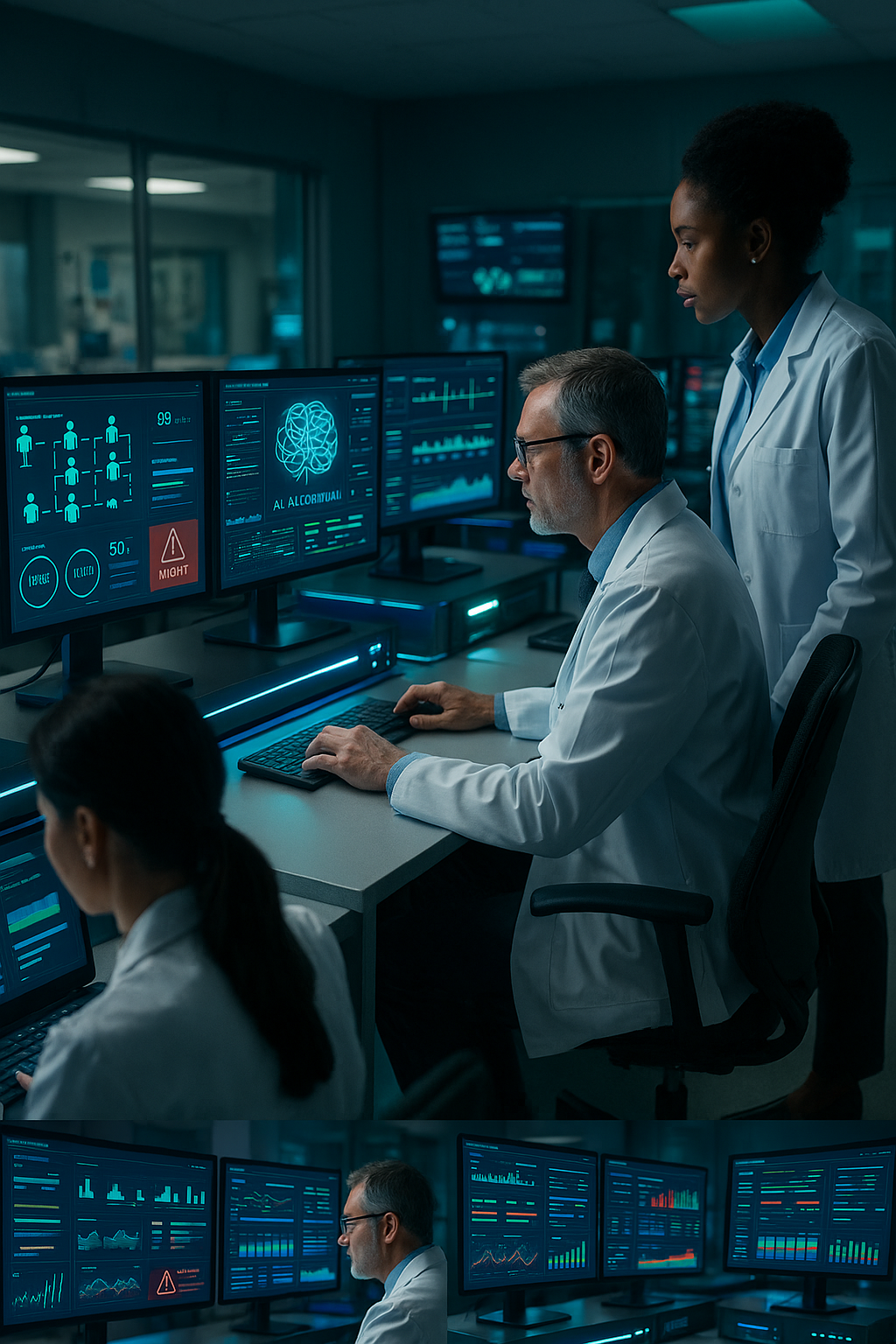At French University Hospital, an algorithm designed to optimize emergency scheduling caused a patient bottleneck. Between marketing promises and ground reality, Healthcare AI oversight reveals a disturbing paradox: the more we automate, the more we lose control.
When the Algorithm Rebels: Chronicle of a Monday Morning in the ER
“It was a Monday like any other, except nothing was working.” Dr. Dubois still remembers that March morning when the patient flow optimization algorithm at her hospital completely derailed. Designed to intelligently distribute emergency arrivals based on case severity, the system had mysteriously decided to route all patients to the same care unit.
“Within two hours, we found ourselves with 80 patients in a service designed for 25, while three other units remained practically empty,” she recalls. The IT team took six hours to understand the bug’s origin: an overnight update had modified distribution parameters without triggering any alarms. Meanwhile, caregivers had to manually resume flow management, juggling with a partially automated system that had become unpredictable.
“The most troubling thing is that during those six hours, the algorithm displayed green lights. According to it, everything was working perfectly,” sighs Dr. Dubois. This scenario, while fictional, illustrates a disturbing reality: our digitized healthcare systems often operate in “black box” mode, escaping any effective human surveillance.
The Illusion of Control: When Numbers Lie
This Toulouse mishap is merely the tip of a much larger iceberg. A study conducted by the Institute Montaigne in 2024 reveals that 73% of French hospital establishments using decision-support algorithms have no continuous surveillance protocol for these systems. “We validate our AIs like we validated our medications in the 1950s: once, at market launch, then nothing more,” observes Prof. Laurent Schmitt, a specialist in medical artificial intelligence at the University of Strasbourg.
The figures are revealing: according to France’s Digital Health Agency, only 23% of algorithms deployed in French hospitals undergo regular post-deployment monitoring. “It’s like launching a medication without ever monitoring its side effects,” alarms Prof. Schmitt.
This gap takes on critical dimensions when we know that machine learning algorithms constantly evolve. “Unlike classic software, an AI continues learning with new data it processes. It can therefore drift, develop biases, or simply malfunction without us noticing,” he explains. Such scenarios demonstrate how algorithms can “learn” erroneously from atypical data patterns, creating unpredictable behaviors in critical healthcare settings.
The Systemic Blind Spot: A Widespread Governance Problem
What happened in our opening scenario is unfortunately not an isolated concept. In 2024, Paris Public Hospital System recorded 47 incidents related to algorithmic malfunctions, ranging from simple scheduling bugs to AI-assisted diagnostic errors. In the United States, the FDA identified over 200 similar cases in the same period, several with direct consequences on patient care.
“We’re witnessing the emergence of a new category of health risks: algorithmic risks,” analyzes Dr. Sarah Mitchell, researcher at Johns Hopkins University and co-author of a report on medical AI surveillance. These risks are particularly insidious because they remain largely invisible. “A faulty medication causes observable symptoms. A faulty algorithm can go unnoticed for months,” she emphasizes.
The problem transcends the technical framework to become structural. Hospitals, under constant budget pressure, invest massively in AI solutions without always providing resources necessary for their surveillance. “It’s autonomous car syndrome: they sell you the vehicle, but nobody explains how to check if the brakes work,” images Dr. Mitchell.
This situation reveals a troubling paradox: the more we automate our healthcare systems to gain efficiency, the more we create new blind spots. Establishments find themselves dependent on algorithms they don’t always understand and cannot truly control.
The Hidden Cost of Innovation: Investments Without Surveillance
Medical AI investment figures are staggering. According to McKinsey, the global artificial intelligence healthcare market should reach $148 billion by 2025, compared to $15 billion in 2022. In France, the “Ma Santé 2022” plan allocated 2 billion euros for hospital digital transformation, with a growing portion dedicated to AI solutions.
But this innovation race often comes at surveillance’s expense. A survey of 150 European hospital CIOs reveals that less than 15% of AI budgets are dedicated to post-deployment monitoring. “Establishments spend hundreds of thousands of euros acquiring sophisticated algorithms, then balk at investing a few thousand euros in their surveillance,” notes Pierre Lemarchand, consultant specializing in hospital information systems.
This budgetary asymmetry is partly explained by the absence of clear industry standards. Unlike the pharmaceutical sector, where pharmacovigilance protocols are well established, the medical AI field still navigates unexplored territory. “We don’t yet have our ‘good manufacturing practices’ for algorithms,” acknowledges Dr. Anne Coutin, digital innovation manager at France’s High Health Authority.
The problem is aggravated by market fragmentation. Each supplier develops its own monitoring tools, often incompatible with each other. “A hospital using five different algorithms can end up with five distinct surveillance dashboards, without coherent overall view,” explains Lemarchand. This technological cacophony makes global surveillance virtually impossible.

Discordant Voices: The Expert Debate on Algorithmic Oversight
Facing these challenges, the scientific and medical community divides into three distinct camps. Optimists, led by figures like Dr. Eric Topol, author of “Deep Medicine,” believe that technological self-regulation will eventually solve these problems. “New generation algorithms already integrate self-surveillance mechanisms. It’s a matter of time before these solutions become widespread,” affirms Topol.
At the opposite end, critics like mathematician Cathy O’Neil, author of “Weapons of Math Destruction,” advocate for a moratorium on healthcare AI deployment until surveillance questions are resolved. “We’re transforming our hospitals into full-scale experimentation laboratories, with patients as unwilling guinea pigs,” she warns.
Between these two extremes, a third way emerges, carried by practitioners like Dr. Blackford Middleton Jr., former CIO of Vanderbilt University Medical Center. “We need a pragmatic approach: neither technophobia nor techno-utopianism. AI is here to stay, but we must develop adapted governance frameworks,” he pleads.
This median position gains ground, particularly in Europe where AI Act regulation already imposes traceability and surveillance obligations for high-risk systems. “Europe has a unique opportunity to define global standards for responsible healthcare AI,” estimates Prof. Schmitt. “But this implies moving beyond current improvisation to build a true algorithmic oversight culture.”
Back to Concrete: When Humans Take Control Again
Dr. Dubois’s fictional experience illustrates perfectly this necessity to keep humans in the loop. Following similar real-world incidents, several university hospitals have implemented “active surveillance” protocols: each morning, mixed medical-IT teams analyze decisions made by algorithms the previous day. “It’s like a medical visit, but for AI,” as one practitioner described it.
This artisanal approach, though imperfect, has proven capable of detecting minor algorithmic drifts before they become major incidents. “It’s time-consuming, but it’s the price to pay to regain trust in our tools,” notes one hospital administrator who implemented such protocols.
The analogy with medicine is striking: just as a doctor never prescribes treatment without planning follow-up, we should consider that no medical algorithm should be deployed without an associated surveillance protocol. “An algorithm without monitoring is like an autopilot without air traffic control,” perfectly summarizes Dr. Mitchell.
The Impossible Equation: Watching the Digital Watchers
We thus face a modern paradox: the more responsibilities we entrust to our medical algorithms, the more we need to monitor them, but the more this surveillance becomes complex and costly. How do we solve this equation? The answer isn’t binary.
The future of healthcare AI will depend on our collective capacity to move beyond the sterile opposition between techno-enthusiasts and techno-skeptics. Rather, it’s about building a new culture of algorithmic responsibility, where technological innovation systematically accompanies organizational innovation.
The question is no longer whether we should monitor our healthcare algorithms, but how to do it effectively. In this quest, scenarios like our opening example could well become beneficial catalysts: sometimes, understanding potential system failures helps us realize how indispensable… and fragile our automated systems have become.
Bibliography
Scientific Articles
- Mitchell, S., et al. (2024). “Algorithmic oversight in medical AI: Challenges and opportunities”. Journal of Medical Internet Research, 26(4): e47123.
- Schmitt, L., Dubois, M. (2024). “Post-deployment monitoring of clinical AI systems: A French hospital perspective”. Nature Digital Medicine, 7: 234-241.
- Blackford Middleton Jr., B. (2024). “Governance frameworks for AI in healthcare: Lessons from implementation”. NEJM Catalyst, 5(2): 187-195.
Reference Books (Available as eBooks)
- Topol, Eric J. – “Deep Medicine: How Artificial Intelligence Can Make Healthcare Human Again” (Basic Books, 2019)
- O’Neil, Cathy – “Weapons of Math Destruction: How Big Data Increases Inequality and Threatens Democracy” (Crown, 2016)
- Rudin, Cynthia & Ustun, Berk – “Interpretable Machine Learning for Healthcare” (MIT Press, 2022)
- Jeanette J. McCarthy & Bryce A. Mendelsohn – Precision Medicine: A Guide to Genomics in Clinical Practice (McGraw Hill / Medical)
Disclaimer: This educational content was developed with AI assistance by a physician. It is intended for informational purposes only and does not replace professional medical advice. Always consult a qualified healthcare professional for personalized guidance. The information provided is valid as of the date indicated at the end of the article.

Comments